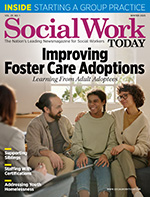|
Winter 2025 Issue Leadership: Gun Violence Prevention How Social Workers Can Lead the Way in the Gun Violence Prevention Movement Gun violence has become known as a public health crisis in the United States, an urgent, life-threatening trend that is entirely preventable.1 According to the Johns Hopkins Center for Gun Violence Solutions data, in 2022, more than 48,000 people died from firearms in the United States, the second highest total ever recorded—this means someone in the United States was killed by a gun every 11 minutes. Of this number, more than 27,000 deaths were firearm suicides, the highest number ever recorded, followed by more than 19,000 homicides, with the remaining small percentage accounting for accidents, police-involved gun fatalities, and undetermined incidents.2 The gun death rate in the United States is much higher than in other developed nations. According to the Pew Research Center, in 2016, the US gun death rate was 10.6 per 100,000 people, which was far higher than in countries such as Canada (2.1), Australia (1.0), France (2.7), Germany (0.9), and Spain (0.6).3 The problem of firearm violence most profoundly affects children and youth. In 2020, firearm-related injuries became the leading cause of death for US children and teens aged 1 to 19, according to the American Academy of Pediatrics. About one-third of American children live in homes with firearms, 43% of which include at least one unlocked firearm.4 School shootings have been on the rise since the pandemic, particularly in the South and Mid-Atlantic regions of the country.5 Neil B. Guterman, PhD, MSW, serves as the Paulette Goddard Professor and dean emeritus at the New York University Silver School of Social Work, where he has been conducting research on preventing children’s exposure to violence and teaching social workers for over three and a half decades. “Since 2020, gun deaths have become the leading cause of death among children and adolescents in the United States, having more than doubled over the past decade,” Guterman explains. “The physical, emotional, and social toll that gun violence takes on children, families, and communities is a staggering and spreading one, and the burden is especially acute for Black Americans, who experience a 600% higher homicide rate than other Americans. With this, addressing gun violence has recently been identified as one of the ‘Grand Challenges’ facing our profession as it has dramatic societal, public health, social justice, and moral consequences.” Rebeccah Sokol, PhD, an assistant professor in the School of Social Work and affiliated faculty in the Institute for Firearm Injury Prevention at the University of Michigan, has applied her background in public health to better understand the contributing factors to the gun violence epidemic in the United States. “We know firearm violence and injuries have been a long-standing issue in the United States for the past several decades, and what we’re seeing recently is that trend is increasing,” Sokol says. Social workers are at the forefront of the gun violence prevention movement, working at every level of intervention, from advocating for macro policy changes to delivering microindividual support for those at risk of gun violence. “Social workers are uniquely positioned to address gun violence risk, as we commonly work in settings where clients face special risk for gun violence exposure—for example, in mental health centers, schools, hospitals, community centers, or intimate partner violence service settings,” Guterman says. “Every day, we face tremendous opportunities to potentially interrupt gun violence before it happens. While social workers are trained to assess and intervene for such concerns as suicide risk or risk for fighting, we still need evidence-based practices to specially address risk when firearms may be in the picture.” The Social Workers Addressing Firearm Risk (SAFR) training developed by Patricia Logan-Greene and Mickey Sperlich at University at Buffalo is a fully online training that aims to help social workers understand, recognize, and respond to the risk of firearm violence, including suicide, with their clients. SAFR boasts promising preliminary evidence, yet much more work needs to be done to urgently address this growing need around the nation. “Social workers have a critical role to play in reducing gun violence in the United States,” Guterman urges, “and can save lives and prevent traumatic harm in our clients’ lives.” In addition to obtaining specialized training in gun violence prevention, there are several ways that social workers can make a difference. Advocate for Gun Protection Policies “Social workers are doing so much in this area,” Sokol says. “For example, recently, the state of Michigan passed a lot of different safety measures including safe storage laws and extreme risk protection orders, and social workers played a significant role in advocating for these types of policy changes.”6 The NASW has partnered with Brady, a nonprofit organization campaigning against gun violence. More information on how social workers can work toward important policy changes can be found on Brady’s website at www.bradyunited.org/take-action. Facts and Figures Known as the Dickey Amendment, the appropriations bill stated that “none of the funds made available for injury prevention and control at the Centers for Disease Control and Prevention may be used to advocate or promote gun control.” This vague statement halted research funding for more than two decades until mounting pressure to address gun violence led to clarification from congressional leaders in 2018 that the rule applies only to advocacy and not research, resuming the opportunity for funding to continue in 2020.8 Today, social workers can take the lead on investigating the impacts of gun violence, the promise of various prevention measures and policies, and social work best practices when it comes to assessing and addressing gun violence issues with clients. “We urgently need evidence-supported interventions that work to reduce gun violence so social workers can Fostering School Connections School social workers can lead the way in community-building efforts to cultivate a warm, unified school culture to protect against violence. Many school districts are choosing to hire additional school social workers to help prevent future instances of gun violence by providing early identification and intervention, screening, risk assessment, referral, and ongoing support.9 Firearm Safety Resources Social workers can prepare to connect clients with resources in their community related to firearm safety by taking the time to learn about how to access proper locking devices, storage options, and safe removal and disposal programs in the area. “Local Police Departments and sheriff’s offices often give away free locking devices,” Sokol suggests, “so that’s another place that you can potentially direct clients.” Reducing Firearm Access Families should avoid keeping firearms in the home and instead opt to participate in community safe gun disposal programs or opt to house the firearm at a shooting range, gun store, or other off-site location where children will not have access to it. If the firearm is kept in the home, it must be stored away, locked, and unloaded with ammunition stored separately. “Social workers can and should become comfortable assessing firearm access, as well as safe storage and use in their clients, and receive training in how to do so in their practice. And they should be aware of the legal avenues available and guardrails in their roles when addressing firearm risk,” Guterman adds. While gun violence is a disturbing reality in America, change is possible, and social workers can lead the way in the movement toward a safer country for all people. “Firearm violence, injuries, and deaths are all preventable,” Sokol says. “There’s so much we can do to stop and reverse this trend and prevent every firearm injury that occurs. It can feel daunting and overwhelming when we look back and see that, unfortunately, this is a huge problem in the United States, and there is so much that we can do about it.” — Heather Rose Artushin, MSW, LISW-CP, is a writer with over a decade of published experience and a passion for social justice.
Resources Institute for Firearm Injury Prevention’s Educational Resources & Guides: https://firearminjury.umich.edu/resources-communities/educational-resources-guides
References 2. Annual firearm violence data. Johns Hopkins Bloomberg School of Public Health website. https://publichealth.jhu.edu/center-for-gun-violence-solutions/annual-firearm-violence-data. Published September 2024. 3. What the data says about gun deaths in the US. Pew Research Center website. https://www.pewresearch.org/short-reads/2023/04/26/what-the-data-says-about-gun-deaths-in-the-u-s/. Published April 26, 2023. 4. Gun safety and injury prevention. American Academy Pediatrics website. https://www.aap.org/en/patient-care/gun-safety-and-injury-prevention/. Updated June 20, 2023. 5. Leeds Matthews A, O’Kruk A, Choi A. School shootings in the US: fast facts. CNN website. https://www.cnn.com/us/school-shootings-fast-facts-dg/index.html. Updated December 16, 2024. 6. Michigan Supreme Court. Extreme Risk Protection Order Act 2023 PA 38. https://www.courts.michigan.gov/4915f8/siteassets/publications/manuals/erpo/manual-extreme-risk-protection-order.pdf. Published February 7, 2024. 7. Kellermann AL, Rivara FP, Rushforth NB, et al. Gun ownership as a risk factor for homicide in the home. N Engl J Med. 1993;329(15):1084-1091. 8. Weir K. A thaw in the freeze on federal funding for gun violence and injury prevention research. American Psychological Association website. https://www.apa.org/monitor/2021/04/news-funding-gun-research. Published April 1, 2023 9. Johnson D, Barsky AE. Preventing gun violence in schools: roles and perspectives of social workers. School Social Work Journal. 2020;44(2):26-48. |


